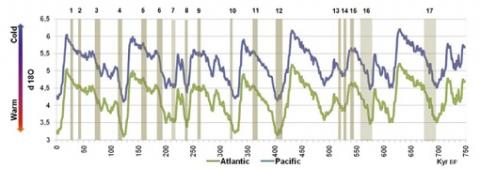Orgeira M.J., Sinito A.M. y Compagnucci R.H.
2 017
Latinmag Letters, Volume 7, Special Issue (2017), GEP09, 1-4. Proceedings Juriquilla, Qro, Mexico
El análisis de esta contribución considera que, hay un aumento de Rayos Cósmicos Galácticos (RCG) en el espacio por el nacimiento de una supernova cercana a nuestro sistema solar. Este evento se habría iniciado en torno a los 2.8 a 2.6 Ma y finalizado entre 1.7 y 1.5 Ma con un pico alrededor de los 2.2 Ma; ello conllevaría a un mayor ingreso de radiación a la Tierra. Ese aumento se ve favorecido por el debilitamiento y hasta suspensión del Campo magnético Terrestre durante la reversión entre los Crones Gauss y Matuyama. Todos estos factores sumados generaron un máximo relativo del flujo de RCG sobre la tierra, el cual pudo gatillar el comienzo de la primera glaciación cuaternaria y la aparición de las oscilaciones entre estadios calientes y fríos que caracterizaron el Pleistoceno.
Palabras clave: Paleoclima, rayos cósmicos galácticos, campo magnético terrestre, transición Plio-Pleistocena, supernova.
Palabras clave: Paleoclima, rayos cósmicos galácticos, campo magnético terrestre, transición Plio-Pleistocena, supernova.
This contribution considers that there is an increase of Galactic Cosmic Rays (GCR) in space due to the birth of a supernova near our solar system. This event would have started around 2.8 to 2.6 Ma and finished between 1.7 and 1.5 Ma with a peak around 2.2 Ma; a consequent increase of radiation input to Earth took place. This increase is favored by the weakening and even suspension of the Earth’s magnetic field during the reversion between the Gauss and Matuyama Chrones. All these factors generated a relative maximum of the GCR flux on the earth, which could act as trigger of the beginning of the first Quaternary glaciation and the appearance of the oscillations between warm and cold stages that characterized the Pleistocene.
Key words: Paleoclimate, galactic cosmic ray, geomagnetic field, Plio-Pleistocene boundary, supernova.
Key words: Paleoclimate, galactic cosmic ray, geomagnetic field, Plio-Pleistocene boundary, supernova.

